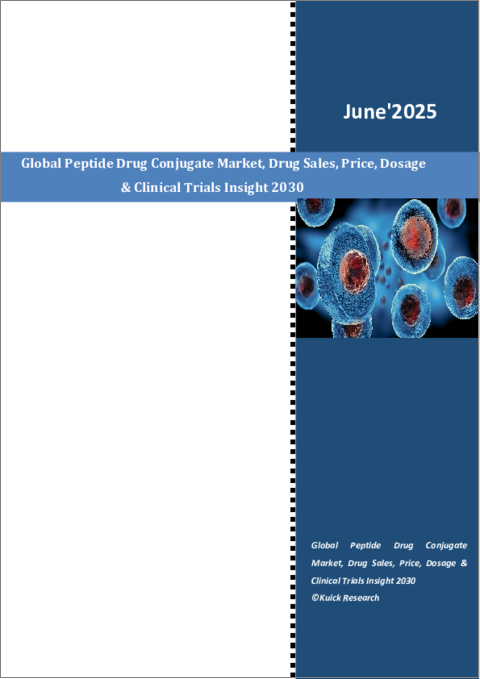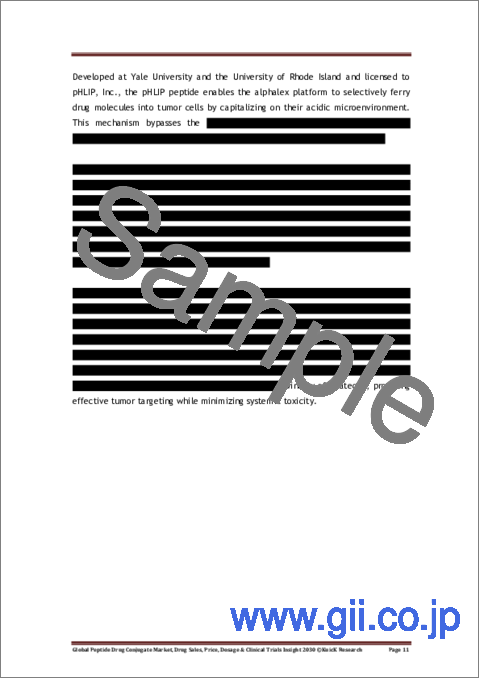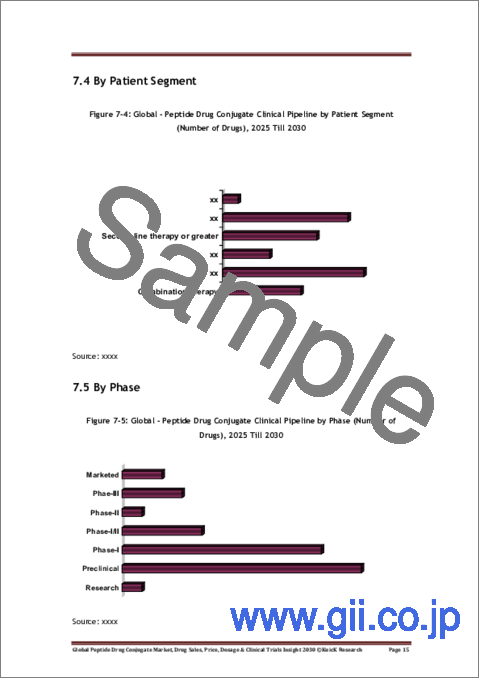|
|
市場調査レポート
商品コード
1742161
ペプチド薬物複合体の世界市場:薬剤売上、価格、用量、臨床試験動向(2030年)Global Peptide Drug Conjugate Market, Drug Sales, Price, Dosage & Clinical Trials Insight 2030 |
||||||
|
|||||||
| ペプチド薬物複合体の世界市場:薬剤売上、価格、用量、臨床試験動向(2030年) |
|
出版日: 2025年05月01日
発行: KuicK Research
ページ情報: 英文 120 Pages
納期: 即日から翌営業日
|
全表示
- 概要
- 図表
- 目次
ペプチド薬物複合体の世界市場:薬剤売上、価格、用量、臨床試験動向(2030年)レポートハイライト
- ペプチド薬物複合体の世界市場機会:>14億米ドル
- ペプチド薬物複合体の世界市場動向:地域別、適応症別
- ペプチド薬物複合体の世界市場成長率2018-2024年:>絶対成長率300%以上、CAGR成長率27%以上
- 承認済みペプチド薬物複合体の用量、販売、価格に関する洞察
- 承認済みペプチド薬物複合体の世界売上高および地域別インサイト:承認済み2薬剤
- 世界のペプチドコンジュゲート臨床試験インサイト:>30品目以上
- 世界のペプチド薬物複合体の臨床試験インサイト:企業別、国別、適応症別、相別
- ペプチド薬物複合体の独自技術と調査手法:企業別
世界のペプチド薬物複合体市場はまだ初期段階にあり、ここ数年で関心と投資が高まっているにもかかわらず、承認された治療法はわずかです。現在、医薬品規制当局から承認を受けているペプチド薬物複合体は2つしかありません。その最初のものであるNovartisのルタセラは、2017年に欧州医薬品庁から消化管膵神経内分泌腫瘍の成人患者の治療薬として承認を受け、大きなブレークスルーとなっています。続いて2018年には米国FDAの承認が下りました。興味深いことに、この薬剤の適応は2024年に小児患者にも拡大されました。これは珍しい動きであり、小児がん領域における重要なブレークスルーです。
承認された2番目のペプチド薬物複合体であるOncopeptidesのPepaxtoは、多発性骨髄腫を対象として上市され、2021年にFDAから承認されました。しかし、その道のりは平坦ではありません。安全性と有効性に問題があったため、承認された年に米国市場から撤退し、2024年に正式に承認が取り消されました。しかし、欧州市場には残っています。Oncopeptidesは、特にアジアを中心に、その他の規制上の機会も積極的に追求しています。例えば、2024年には日本のPMDAとさらなる薬事協議に着手し、Pepaxtiの同市場への導入を目指しています。この措置は、国境を越えた規制要件の同期化が進み、ペプチド薬物複合体治療に対する利害関係者の関心が高まっていることを反映しています。
現在、30以上のペプチド薬物複合体候補が活発に臨床開発されていますが、その大半は初期段階にあります。これは、この分野の新規性と可能性を裏付けています。ペプチド化学と薬物複合手法の着実な革新が、この開発を後押ししています。ペプチドをペイロードに結合させるための化学的リンカーの最適化が重要な焦点の一つとなっています。リンカーは、活性のある薬物を標的部位に正確に放出させ、効能と安全性を高める上で極めて重要です。安定性と選択性の向上がこうした技術革新の原動力となっており、がん細胞により的を絞った送達を可能にし、健康な組織への害を減らしています。
ペプチド薬物複合体開発の高度化により、製薬会社はBOC SciencesやPeptistarのような高度に専門化された研究開発受託会社と協力するようになっています。これらの共同開発企業は、ペプチド合成、ペイロード設計、コンジュゲーション戦略などに関する高度な専門知識を持ち、初期段階の開発には欠かせない存在となっています。このような協力モデルにより、企業はより迅速に反復し、コストを削減し、新しい候補化合物をより効率的に臨床に導入することができます。
地理的には、米国と中国が、強力な投資エコシステムとトップクラスの学術機関が支援する研究開発努力をリードしています。しかし、世界各地から多数の企業が重要な貢献をしています。NovartisとOncopeptidesは、承認済みの治療薬と後期臨床資産で最前線に君臨しており、Bicycle Therapeutics、PeptiDream、Soricimed Biopharmaのような他の革新的企業は、ターゲティングとペイロード選択における新しいコンセプトを導入しています。開発中の分子形態の幅広さは、PDCプラットフォームの多用途性を反映しています。
受容体特異的ターゲティングの機運が高まっており、薬剤開発者はがん特異的な細胞表面受容体をターゲットとして、より選択的なドラッグデリバリーを実現しようとしています。これは、精密医療を目指す腫瘍学全体の動きの一部です。その目的は、全身毒性を減らし、腫瘍部位での薬効を最大化することです。この技術が成熟し続けるにつれて、従来の治療法では困難であった固形がんにも対応できる可能性があります。業界の成長と技術補助の強化により、ペプチド薬物複合体市場の見通しは、暫定的ではあるが明るいままです。
当レポートは、世界のペプチド薬物複合体市場について調査し、市場の概要とともに、薬剤動向、臨床試験動向、地域別動向、および市場に参入する企業の競合情勢などを提供しています。
目次
第1章 ペプチド薬物複合体のイントロダクション
- 概要
- 歴史と進化
- ペプチド薬物複合体と抗体薬物複合体
第2章 ペプチド薬物複合体- 構造成分と作用機序
- コンポーネント
- 作用機序
第3章 ペプチド薬物複合体の研究開発動向(適応症別)
- がん
- その他
第4章 世界のペプチド薬物複合体の調査と市場動向(地域別)
- 米国
- 中国
- 日本
- 欧州
- 韓国
第5章 世界のペプチド薬物複合体市場の展望
- 現在の臨床および市場動向
- 将来の市場展望と機会
第6章 ペプチド薬物複合体開発の独自の技術と方法論
第7章 世界ペプチド薬物複合体の臨床パイプラインの概要
- 企業別
- 国別
- 適応症別
- 患者セグメント別
- 相別
第8章 世界ペプチド薬物複合体臨床試験の洞察、企業、国、適応症、相別
- 調査
- 前臨床
- 第I相
- 第I/II相
- 第II相
- 第III相
第9章 市販ペプチド薬物複合体の臨床的洞察
第10章 ルタセラ- 臨床および商業的洞察
- 概要、入手可能性、特許情報
- 投与量と価格分析
- 売上分析
第11章 ペパクスト/ペパクスティ- 臨床および商業的洞察
- 概要、入手可能性、特許情報
- 投与量分析
- 売上分析
第12章 競合情勢
- Angiochem
- Avacta
- Bicycle Therapeutics
- Cybrexa Therapeutics
- ITM Solucin
- Novartis
- Oncopeptides
- PepGen Corporation
- Soricimed Biopharma
- Theratechnologies
List of Figures
- Figure 1-1: Timeline of Key Events in Development of Peptide Drug Conjugates
- Figure 2-1: Peptide Drug Conjugates - Components
- Figure 2-2: Peptide Drug Conjugate - Mechanism Of Action
- Figure 3-1: Approved Peptide Drug Conjugates
- Figure 3-2: TH1902-CTR-0001 Phase I (NCT04706962) Study - Initiation & Completion Year
- Figure 3-3: CBX-12-101 Phase I/II (NCT04902872) Study - Initiation & Completion Year
- Figure 3-4: CBX-12-201 Phase II (NCT06315491) Study - Initiation & Completion Year
- Figure 3-5: Duravelo-1 Phase I/II (NCT04561362) Study - Initiation & Completion Year
- Figure 3-6: Duravelo-2 Phase II/III (NCT06225596) Study - Initiation & Completion Year
- Figure 3-7: Duravelo-3 Phase II (NCT06840483) Study - Initiation & Completion Year
- Figure 3-8: Duravelo-4 Phase II (NCT06933329) Study - Initiation & Completion Year
- Figure 3-9: BT5528-100 Phase I/II (NCT04180371) Study - Initiation & Completion Year
- Figure 3-10: ALS-6000-101 Phase I (NCT04969835) Study - Initiation & Completion Year
- Figure 5-1: Global - Peptide drug Conjugates Market (US$ Million), 2018-2025
- Figure 5-2: Global - Peptide drug Conjugates Market (US$ Million), 2025-2030
- Figure 5-3: Potential Future Directions in Peptide-Drug Conjugate Development
- Figure 6-1: Alphalex Platform - Cybrexa
- Figure 6-2: Decoy Platform - Candidate Life Cycle
- Figure 6-3: Decoy Platform - Modular Peptide Engineering & Conjugation Chemistry
- Figure 6-4: Decoy Platform - Features
- Figure 6-5: EDO Platform - Drug Structure
- Figure 6-6: OncoPDCs - Excellamol
- Figure 6-7: PDPS Platform - PeptiDream
- Figure 6-8: Rational Design Based Drug Discovery - Mainline Biosciences
- Figure 6-9: pre|CISION(R) Platform - Generations & Features
- Figure 6-10: PIP - Mechanism of Action
- Figure 6-11: PIP Platform - TwoStep Toolbox
- Figure 6-12: Peptide - Advantages
- Figure 6-13: SORT1+ Technology - PDC Structure
- Figure 6-14: MPD-1 - Mechanism of Action
- Figure 6-15: Bi-XDC Technology - Coherent Biopharma
- Figure 6-16: NIPEP-TPP - NIBEC
- Figure 7-1: Global - Peptide Drug Conjugate Clinical Pipeline by Company (Number of Drugs), 2025 Till 2030
- Figure 7-2: Global - Peptide Drug Conjugate Clinical Pipeline by Country (Number of Drugs), 2025 Till 2030
- Figure 7-3: Global - Peptide Drug Conjugate Clinical Pipeline by Indication (Number of Drugs), 2025 Till 2030
- Figure 7-4: Global - Peptide Drug Conjugate Clinical Pipeline by Patient Segment (Number of Drugs), 2025 Till 2030
- Figure 7-5: Global - Peptide Drug Conjugate Clinical Pipeline by Phase (Number of Drugs), 2025 Till 2030
- Figure 10-1: Lutathera - Approval Year by Region
- Figure 10-2: Lutathera - Patent Filing & Expiration Year
- Figure 10-3: Global - Lutathera Sales (US$ Million), 2018-2025
- Figure 10-4: Global - Lutathera Quarterly Sales (US$ Million), 2025
- Figure 10-5: Regional - Lutathera Sales (US$ Million), Q1'2025
- Figure 10-6: Regional - Lutathera Sales (US$ Million), Q1'2025
- Figure 10-7: Global - Lutathera Quarterly Sales (US$ Million), 2024
- Figure 10-8: US - Lutathera Quarterly Sales (US$ Million), 2024
- Figure 10-9: US - Lutathera Sales (US$ Million), 2023-2025
- Figure 10-10: ROW - Lutathera Quarterly Sales (US$ Million), 2024
- Figure 10-11: ROW - Lutathera Sales (US$ Million), 2023-2025
- Figure 11-1: Pepaxto/Pepaxti - Approval Year by Region
- Figure 11-2: Pepaxti - Patent Filing & Expiration Year
- Figure 11-3: Europe - Pepaxti Sales (US$ Million), 2021-2025
List of Tables
- Table 1-1: Antibody Drug Conjugates v/s Peptide Drug Conjugates
- Table 10-1: Lutathera - Recommended Amino Acid Solution Dosing
- Table 10-2: Lutathera - Recommended Dosage Modifications for Adverse Reactions
- Table 11-1: Pepaxti - Recommended Dose Reduction for Adverse Reactions
- Table 11-2: Pepaxti - Recommended Dose Modifications for Adverse Reactions
Global Peptide Drug Conjugate Market, Drug Sales, Price, Dosage & Clinical Trials Insight 2030 Report Highlights:
- Global Peptide Drug Conjugate Market Opportunity: > USD 1400 Million
- Global Peptide Drug Conjugate Market Trends By Region & Indications
- Global Peptide Drug Conjugate Market Growth 2018-2024: > 300% Absolute Growth & 27% CAGR Growth
- Approved Peptide Drug Conjugate Dosage, Sales & Price Insight
- Approved Peptide Drug Conjugate Sales Global & Regional Insight: 2 Drugs Approved
- Global Peptide Drug Conjugate Clinical Trials Insight: > 30 Drugs
- Global Peptide Drug Conjugates Clinical Trials Insight By Company, Country, Indication & Phase
- Peptide Drug Conjugate Proprietary Technologies & Methodologies Insight By Company
The global peptide drug conjugate market is still in its nascent stage, with only a few approved therapies despite rising interest and investment over the last few years. Currently, there are only 2 peptide drug conjugates have received approval from drug regulatory agencies. The first of these, Novartis' Lutathera, was a major breakthrough in 2017 when it received approval from the European Medicines Agency for the treatment of adult patients with gastroenteropancreatic neuroendocrine tumors. This was subsequently followed by US FDA approval in 2018. Interestingly, the indication for the drug was also expanded in 2024 to paediatric patients, a rare move and a significant breakthrough in the paediatric oncology sector.
The second peptide drug conjugate that has been approved, Oncopeptides' Pepaxto, was launched for multiple myeloma and was approved by the FDA in 2021, while a year later it got the thumbs up from the EMA. Its journey was not as smooth, though. It was withdrawn from the US market in the year it was approved because of safety and efficacy issues, reaching the point of official withdrawal of its approval in 2024. However, the product remains on the Europe market. Oncopeptides has also been actively pursuing other regulatory opportunities, notably in Asia. For instance, in 2024, it embarked on further regulatory discussions with Japan's PMDA, aiming to bring Pepaxti into that market. This step mirrors increasing synchronization of regulatory requirements across borders and increasing interest among industry stakeholders in peptide drug conjugate therapies.
Today, there are over 30 peptide drug conjugate candidates in active clinical development, with the majority lying in early stages. This underscores the field's novelty and potential. Steady innovation in peptide chemistry and drug conjugation methodologies is driving this development. One key area of focus has been the optimization of the chemical linkers used to attach peptides to their payloads. The linkers are crucial in ensuring that the active drug is released exactly at the target location, thus enhancing efficacy and safety. Improvements in stability and selectivity are powering these innovations, allowing for more targeted delivery to cancer cells and reducing harm to healthy tissue.
The growing sophistication of peptide drug conjugate development has led pharmaceutical firms to collaborate with highly specialized contract research and development firms, such as BOC Sciences and Peptistar. These collaborators bring advanced expertise in peptide synthesis, payload design, and conjugation strategies, among others, making them essential during early-stage development. This model of collaboration is enabling companies to iterate more quickly, lower their costs, and get new candidates into the clinic more effectively.
Geographically, the US & China are leading the research and development effort with strong investment ecosystems and top academic institutions supporting them. However, a large number of companies from all around the globally are making important contributions. Novartis and Oncopeptides remain at the forefront with their approved therapies and late-stage clinical assets, while other innovators like Bicycle Therapeutics, PeptiDream, and Soricimed Biopharma are introducing new concepts in targeting and payload choice. The range of molecular forms under development is a reflection of the versatility of the PDC platform.
There is increasing momentum behind receptor-specific targeting, with drug developers targeting cancer-specific cell surface receptors to provide more selective delivery of drugs. This is part of an oncology-wide movement toward precision medicine. The aim is to decrease systemic toxicity and maximize drug effect at the tumor site. As this technology continues to mature, it has the potential to address difficult solid tumors that have so far been resistant to traditional treatments. With the industry growing and technology aids enhancing, prospects for the peptide drug conjugate market remain brighter although tentatively so.
Table of Contents
1. Introduction To Peptide Drug Conjugates
- 1.1 Overview
- 1.2 History & Evolution
- 1.3 Peptide Drug Conjugates v/s Antibody Drug Conjugates
2. Peptide Drug Conjugates - Structural Components & Mechanism of Action
- 2.1 Components
- 2.2 Mechanism of Action
3. Peptide Drug Conjugates Research & Development Trends By Indication
- 3.1 Cancer
- 3.2 Others
4. Global Peptide Drug Conjugates Research & Market Trends By Region
- 4.1 US
- 4.2 China
- 4.3 Japan
- 4.4 Europe
- 4.5 South Korea
5. Global Peptide Drug Conjugates Market Outlook
- 5.1 Current Clinical & Market Trends
- 5.2 Future Market Outlook & Opportunities
6. Peptide Drug Conjugate Development Proprietary Technologies & Methodologies
7. Global Peptide Drug Conjugates Clinical Pipeline Overview
- 7.1 By Company
- 7.2 By Country
- 7.3 By Indication
- 7.4 By Patient Segment
- 7.5 By Phase
8. Global Peptide Drug Conjugates Clinical Trials Insight By Company, Country, Indication & Phase
- 8.1 Research
- 8.2 Preclinical
- 8.3 Phase-I
- 8.4 Phase-I/II
- 8.5 Phase-II
- 8.6 Phase-III
9. Marketed Peptide Drug Conjugates Clinical Insight
10. Lutathera - Clinical & Commercial Insight
- 10.1 Overview, Availability & Patent Insight
- 10.2 Dosage & Price Analysis
- 10.3 Sales Analysis
11. Pepaxto/Pepaxti - Clinical & Commercial Insight
- 11.1 Overview, Availability & Patent Insight
- 11.2 Dosage Analysis
- 11.3 Sales Analysis
12. Competitive Landscape
- 12.1 Angiochem
- 12.2 Avacta
- 12.3 Bicycle Therapeutics
- 12.4 Cybrexa Therapeutics
- 12.5 ITM Solucin
- 12.6 Novartis
- 12.7 Oncopeptides
- 12.8 PepGen Corporation
- 12.9 Soricimed Biopharma
- 12.10 Theratechnologies






